Disclosure: We may earn commissions if you purchase products after clicking on a link from our site.
Do you want to learn how to catch cobia? Cobia fishing can be challenging as it requires good angling skills, patience, and high-quality gear because of its size and strength. However, cobia is an excellent gamefish and also good for eating. Cobia is found on the Atlantic and Gulf coasts. Cobia is a migratory fish that goes to the south in winter and moves up north in summer. In this article, we share information and fishing techniques to help you learn how to catch cobia.
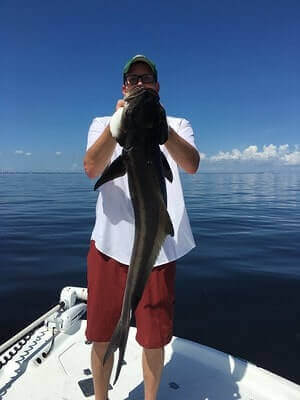
Table of Contents
- 1 How To Catch Cobia
- 2 How To Catch Cobia From Shore
- 3 How To Catch Cobia In Florida
- 4 How To Catch Cobia From A Pier
- 5 How To Catch Cobia In North Carolina
- 6 How To Catch Cobia In South Carolina
- 7 How To Catch Cobia In Chesapeake Bay
- 8 How To Catch Cobia In The Gulf
- 9 Cobia Fishing Setup
- 10 Best Baits For Cobia
- 11 Best Cobia Fishing Lures
- 12 Cobia Fishing Tips
- 13 The Bottom Line
How To Catch Cobia
1. Chumming
Chumming is a fishing technique that involves dropping bait or lure into the water at an interval to get the attention of the fish. Use shrimp heads or die-offs from the local seafood store. Drop the bait at regular intervals and cobia and other fish will eat them up. As you do this regularly, send down your line with the bait and the cobia will strike.
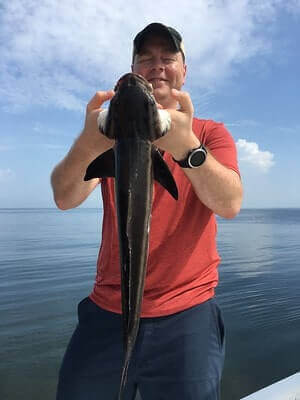
2. Sight Fishing
Sight-fishing is one of the ways to fish for cobia. When they are near the surface, it is easy to see them. However, sight-fishing cobia is challenging as they are not really hungry when you spot them near the surface. They are bottom feeders and are usually full from feeding on the bottom when they swim near the surface.
When you spot cobia near the surface, you can entice them to strike by dropping live bait like eels, mullet, or shrimp. Always throw the bait a little distance from the cobia and retrieve it until it is about 10 or 12 feet in front of it. Then free spool the reel.
You can also use lures to attract the cobia when sight-fishing. Use jigs, bucktails, plugs, and spoons to get cobia on the surface to strike. You can cast a jig about 5 or 10 feet in front of the fish and let it free fall. Cobia seems to always get attracted to lures that are going straight down and will go after it. You will feel a bump on your line and that will be the signal that the cobia has struck.
If cobia appear close to your boat and then suddenly disappear, most likely they have swam underneath the boat. Just drop bait or lure close to the boat and they will lunge from underneath the boat.
3. Trolling
Trolling can also be used to catch cobia. When trolling for cobia, you want to keep a speed between 4 and 6 knots. Let the line out behind the boat about 50 to 150 feet with a variety of lures. Additionally, use 40 to 60-pound class gear. Troll for cobia over shoals, channel edges, coral reefs, and wrecks. When a cobia is hooked on the line, pull in the other lines to prevent tangles.
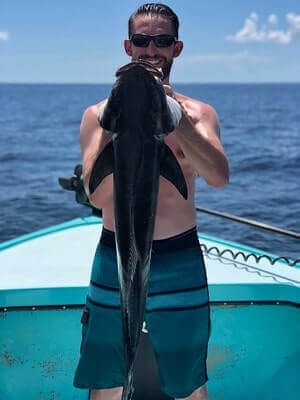
How To Catch Cobia From Shore
When fishing for cobia from the shore, look for jetties, wrecks, troughs, deep holes, points, sand bars, and other structures that they can use as cover to ambush prey. Anglers fish for cobia from the shore, docks, piers, and bridges.
They prey on crabs, squid, small fish, and eels. Fly fishing, casting, jigging, drift fishing, and trolling are used when fishing for cobia from the shore.
How To Catch Cobia In Florida
When fishing for cobia in Florida, look for them near structures like buoys, markers, wrecks, and reefs. They prey on blue crabs, eels, stingrays, and pinfish. Casting, spinning, and fly fishing, are some of the fishing methods used when fishing for cobia.
How To Catch Cobia From A Pier
Anglers fish for cobia from the pier using sight fishing and casting. They prey on crabs, squid, small fish, and eels. Jigs can also be used when fishing for cobia. Look for any structures around piers that can harbor cobia as they wait in ambush for their prey.
How To Catch Cobia In North Carolina
In North Carolina, cobia are found around structures such as reefs, wrecks, buoys, and shelves. They prey on eels, shrimp, crabs, and mackerels. Sight fishing, bottom fishing, casting, fly fishing, trolling, and drift fishing are fishing methods that can be used to catch cobia in North Carolina.
How To Catch Cobia In South Carolina
When fishing for cobia in South Carolina, look for reefs, buoys, and wrecks. Use baits such as squid, eels, shrimp, and crabs to Fish for cobia. Bottom fishing, casting, fly fishing, trolling, and drift fishing are some of the fishing methods that can be used when fishing for cobia in South Carolina.
How To Catch Cobia In Chesapeake Bay
When fishing for cobia in the Chesapeake Bay, look for ledges, drop-offs, lumps, and other structures that cobia may be hanging out waiting in ambush for prey. Chumming, trolling, bottom fishing, jigging, and sight fishing are some of the fishing methods used when fishing for cobia.
Eels, peeler crabs, and menhaden are some of the baits that can be used when fishing for cobia in the Chesapeake Bay. Lures such as jigs can also be used.
How To Catch Cobia In The Gulf
When fishing for cobia in the Gulf of Mexico, look around wrecks, buoys, reefs, and oil rigs. They are found near those structures as they prey on crabs, squid, small fish, and eels. Lures can also be used when fishing for cobia. Casting, jigging, bottom fishing, drift fishing, and trolling can be used to catch cobia.
Cobia Fishing Setup
You can use a medium-heavy 6-to 7-foot spinning rod with a high-quality reel that is spooled with at least 225 yards of 20 to 30-pound test. You need a smooth drag as the cobia is a large and very powerful fish. You can choose between monofilament or the braided line.
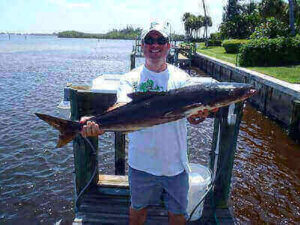
Best Baits For Cobia
1. Eels
Eels are a popular and effective bait choice for targeting cobia, prized gamefish known for their strong fighting ability and impressive size. These elongated, snake-like baits are typically rigged whole or in chunks and fished either live or dead on the bottom or suspended beneath a float.
Eels emit a strong scent that can attract cobia from a distance, making them particularly effective in murky or deep waters where visibility is limited. Anglers often deploy eels around structures such as wrecks, reefs, and buoys, as cobia are known to frequent these areas in search of prey.
When presenting eels as bait, anglers may use heavy tackle to handle the powerful strikes and vigorous fights that cobia is known for. Overall, eels are a reliable bait option for cobia fishing, capable of enticing these formidable gamefish and yielding exciting angling encounters.
2. Croaker
Croaker are a favored bait choice among anglers targeting cobia, prized for their large size and enticing movement in the water. These fish emit strong vibrations and have a distinctive croaking sound, which can attract cobia from a distance.
Croakers can be rigged either live or dead, with live croakers typically hooked through the lips or back, while dead croakers are often filleted or chunked to release their scent into the water. Anglers may use heavy tackle to handle the powerful strikes and fights that Cobia is known for, as these gamefish can grow to impressive sizes and put up a strong battle.
Croakers are particularly effective when fished around structures such as wrecks, reefs, and buoys, where cobia often congregate in search of prey. Overall, croaker make for excellent bait when targeting cobia, offering both visual and olfactory appeal to entice these formidable gamefish.
3. Mullet
Mullets are highly sought-after baitfish when targeting cobia due to their large size, abundance, and attractive swimming action. These resilient fish can be used either live or dead, offering versatility to anglers pursuing cobia in various fishing scenarios.
Live mullet are typically rigged through the lips or back with sturdy hooks to ensure they swim naturally and remain lively in the water, enticing cobia with their vigorous movements. Alternatively, dead mullet can be filleted or chunked to release scent trails that attract cobia from a distance.
Anglers often fish mullet near structures such as buoys, wrecks, and bridge pilings, where cobias are known to frequent in search of prey. With their robust presence and ability to mimic natural baitfish behavior, mullets are an excellent choice for anglers seeking success in cobia fishing endeavors.
4. Crabs
Crabs are highly effective bait for targeting cobia, prized for their natural appeal and ability to entice these powerful gamefish. Blue crabs, in particular, are favored for cobia fishing due to their availability along coastal waters and their tendency to inhabit the same areas as cobia.
Anglers often use both live and freshly caught crabs as bait, presenting them either whole or as chunks on sturdy hooks to ensure they remain intact in the water. Live crabs are typically rigged with circle hooks through the leg sockets or carapace to allow for natural movement, while chunks of fresh crab meat release enticing scent trails to attract cobia from a distance.
Anglers deploy crab baits near structures such as wrecks, jetties, and channel markers, where cobia are known to congregate in search of prey. With their irresistible aroma and lifelike movements, crabs serve as an excellent bait option for anglers targeting cobia in coastal waters.
5. Shrimp
Shrimps are a versatile and widely used bait for cobia fishing, offering a natural and enticing presentation to lure these prized gamefish. Their popularity stems from their availability, ease of use, and attractiveness to cobia.
Anglers can deploy both live and frozen shrimp as bait, with live shrimp often proving more effective due to their lively movements and natural scent. When rigging shrimp for cobia, anglers typically thread them onto sturdy hooks, either whole or in sections, to mimic the appearance of natural prey.
Shrimp can be fished near structures such as wrecks, buoys, and channel markers, where cobia are known to frequent in search of food. Their succulent taste and appealing scent make shrimp an excellent choice for enticing cobia in coastal waters, making them a staple bait in many anglers’ arsenals.
6. Squid
Squid is a popular and effective bait for cobia fishing, prized for its strong scent and durability in the water. Anglers often use fresh or frozen squid as bait, either whole or in strips, which can be rigged on hooks to resemble natural prey.
The tough texture of squid allows it to withstand the rigors of casting and trolling, making it ideal for targeting cobia in a variety of fishing scenarios. Squid’s strong scent is particularly enticing to cobia, attracting them from a distance and increasing the likelihood of a successful catch.
When targeting cobia, anglers may present squid baits near underwater structures such as wrecks, reefs, and navigation buoys, where these fish are known to congregate. Overall, squid is a reliable and versatile bait option for anglers pursuing cobia in coastal waters.
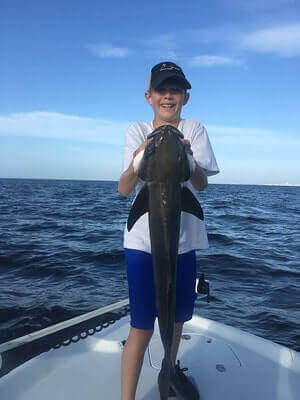
Best Cobia Fishing Lures
1. Bucktail Jigs
Bucktail jigs are highly effective lures for cobia fishing due to their versatility and lifelike action in the water. These jigs typically consist of a lead head adorned with a skirt made of deer hair or synthetic fibers resembling a baitfish.
Anglers can customize the appearance of bucktail jigs by selecting different colors and sizes to mimic the local forage and conditions. When targeting cobia, anglers often cast or jig bucktail jigs around structure-rich areas such as wrecks, reefs, and pilings, where cobia are known to congregate.
The natural swimming motion and flash of the skirt combined with the erratic movements produced by the angler’s retrieve can trigger aggressive strikes from cobia. Additionally, bucktail jigs are relatively easy to use and are suitable for both novice and experienced anglers alike, making them a popular choice for targeting these powerful and prized gamefish.
2. Topwater Plugs
Topwater plugs are an exhilarating choice for targeting cobia, offering anglers an exciting and visual way to entice these powerful fish. These lures typically feature a buoyant body and a concave face designed to create enticing surface commotion, imitating injured baitfish or other prey.
When fishing for cobia with topwater plugs, anglers often target shallow flats, nearshore reefs, and around structure-rich areas such as buoys and jetties where cobia are known to feed. The explosive strikes that occur when a cobia smashes a topwater plug are unmatched in the thrill and adrenaline rush, making this method a favorite among anglers seeking an action-packed fishing experience.
Additionally, topwater plugs allow anglers to cover a lot of water efficiently and can be particularly effective during low-light conditions or when cobia are actively feeding near the surface.
3. Crankbaits
Crankbaits are versatile lures that can be highly effective for targeting cobia in a variety of fishing situations. These lures typically feature a hard plastic body with a diving lip that allows them to dive to specific depths when retrieved.
When fishing for cobia with crankbaits, anglers often opt for larger-sized models that mimic the profile and movement of baitfish, which are the primary prey for cobia. Crankbaits can be fished at various depths, from shallow to deep, depending on the specific model and retrieve speed.
Anglers commonly use crankbaits to cover large areas of water, trolling them behind boats or casting them along structure-rich areas such as reefs, wrecks, and channel edges where cobia are known to congregate. The erratic action of crankbaits can trigger aggressive strikes from cobia, making them a valuable addition to any angler’s arsenal when targeting these powerful gamefish.
4. Cobia Jig
Cobia jigs are a popular and effective lure choice for anglers targeting cobia. These specialized jigs are designed to mimic the appearance and movement of baitfish, which are primary prey for cobia. Typically consisting of a weighted head with a hook and a skirt or soft plastic body, cobia jigs can be worked effectively at various depths in the water column.
Anglers often use them by casting and retrieving near structure-rich areas such as reefs, wrecks, and channel edges, where cobia are commonly found. Additionally, cobia jigs can be vertically jigged near the bottom or trolled behind a boat to cover larger areas of water.
The lifelike action of cobia jigs, combined with their versatility and ability to imitate natural prey, makes them a go-to lure for anglers seeking to entice strikes from these powerful gamefish.
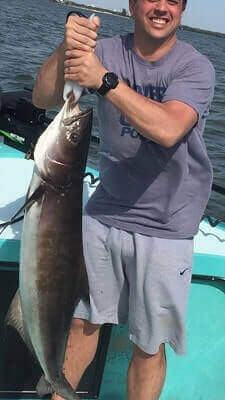
Cobia Fishing Tips
1. Look for temperature breaks and areas with weaker currents than the surrounding areas like tide lines or rip lines when sight-fishing.
2. For sight-fishing, the most important thing is the temperature. Cobia will start to appear when the water temperature reaches 65 degrees Fahrenheit.
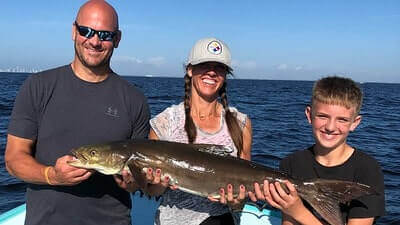
3. Cobia jig is the favorite cobia lure.
4. Cobia does most of its feeding at dawn and dusk.
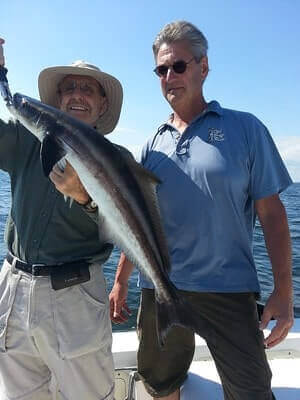
5. Cobia are mainly sight feeders.
6. When fishing for cobia, you can use chumming to attract cobia.
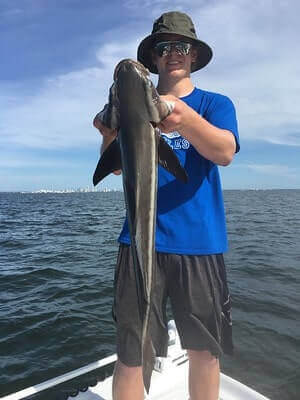
7. Always take along a variety of jigs in different sizes, styles, and colors.
8. Cobia likes structures and can be found around reefs, floating debris, and weed lines.
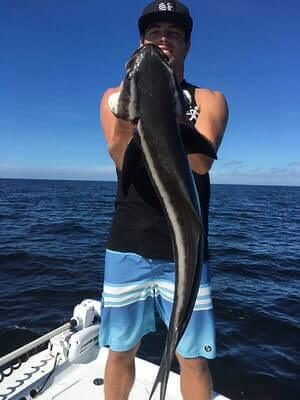
9. When sight-fishing, keep an eye out for sea turtles and rays. Cobia tends to follow these animals in search of an easy meal.
10. Trolling is an effective way to catch cobia.
11. During spring when cobia are spawning, you can use fly fishing to catch cobia.
12. Cobia stay close to the surface when they are migrating. This is when you want to spin and cast.
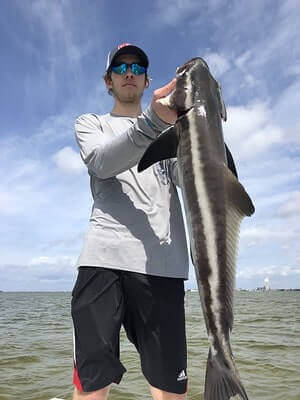
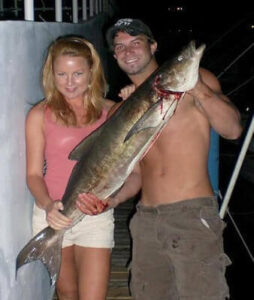
The Bottom Line
Cobia is a hard fighter and with their size and power, it can be a real challenge fishing for them. High-quality equipment, good angling skills, and patience are required to successfully catch cobia.
In this article, we shared knowledge and information to help you catch more cobia during your hunting trips. If you also like to fish for ladyfish, barracuda, and sheepshead, then read these articles how to catch ladyfish, how to catch barracuda, and how to catch sheepshead.